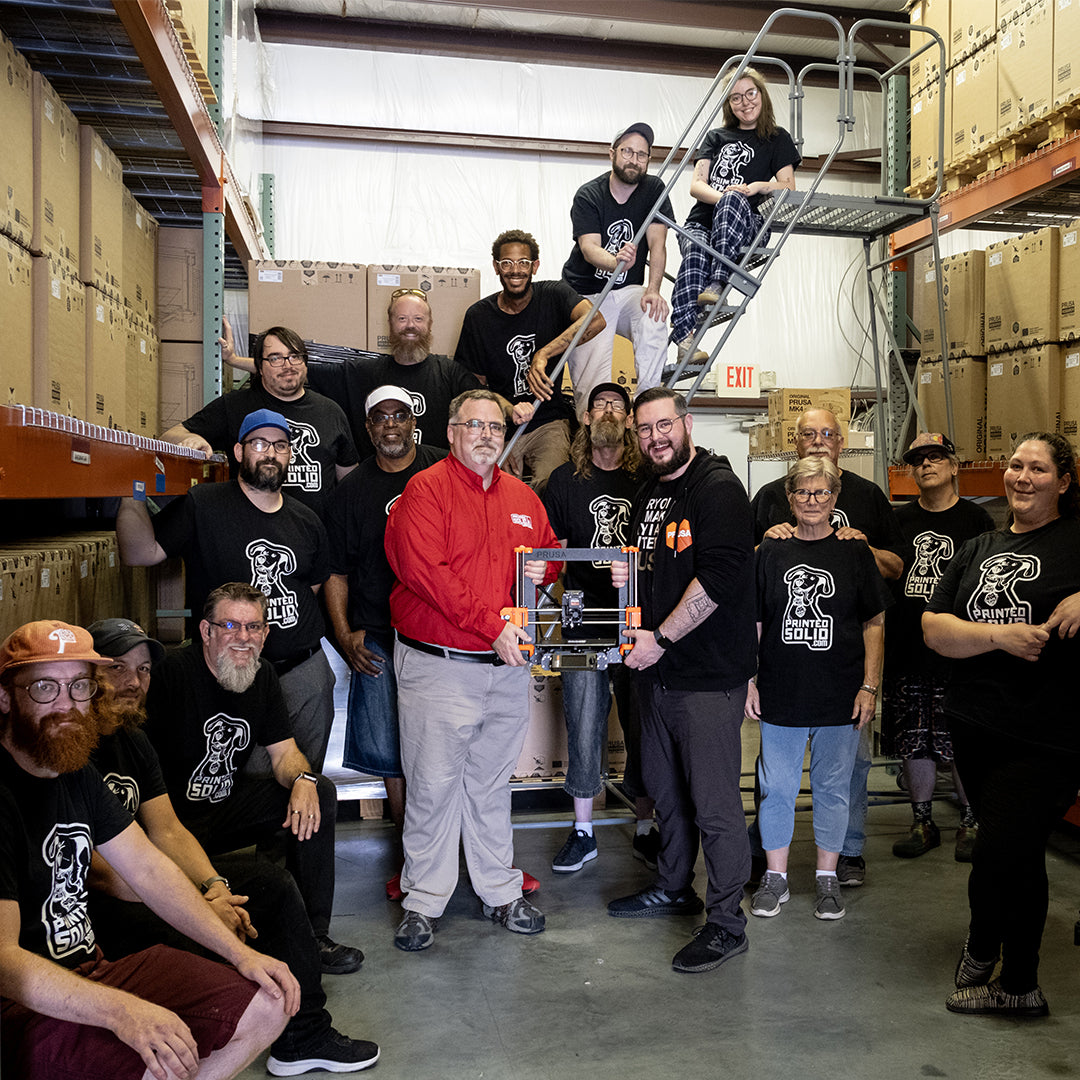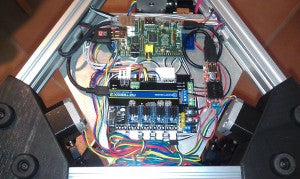
Unboxing the Deltamaker 3D Printer
 Oooh, what a big box. I wonder what could be inside...[/caption] Upon opening it, I was pleased with how well the contents were packaged. Proper space filling packaging techniques were used and there really did not appear to be any significant way for the printer to be damaged from shaking around. A prominent unboxing instruction was also clearly visible. [caption id="attachment_3209" align="aligncenter" width="179"]
Oooh, what a big box. I wonder what could be inside...[/caption] Upon opening it, I was pleased with how well the contents were packaged. Proper space filling packaging techniques were used and there really did not appear to be any significant way for the printer to be damaged from shaking around. A prominent unboxing instruction was also clearly visible. [caption id="attachment_3209" align="aligncenter" width="179"] Well packaged printer in it's shipping box.[/caption] The big box contained the printer, some soft foam insulation packing material, the instruction sheet, and a smaller box. The smaller box contained some goodies.
Well packaged printer in it's shipping box.[/caption] The big box contained the printer, some soft foam insulation packing material, the instruction sheet, and a smaller box. The smaller box contained some goodies.  [caption id="attachment_3206" align="aligncenter" width="300"]
[caption id="attachment_3206" align="aligncenter" width="300"] Smaller box filled with goodies: A printed sample, power supply, t-shirt (I pledged extra for it), scraper, filament spool holder, and a spool of black deltamaker PLA.[/caption] After removing everything from the package, I inspected the machine for any shipping damage. Everything looked to be tight and in great condition. At this point, I noticed one of the nice differentiating features for this machine. It has a magnetically attached build plate. I've heard people have had issues with these on cartesian (like the Makerbot Replicator) machines due to slipping, but it seems like a great idea for a delta where the bed does not move at all. [caption id="attachment_3204" align="aligncenter" width="179"]
Smaller box filled with goodies: A printed sample, power supply, t-shirt (I pledged extra for it), scraper, filament spool holder, and a spool of black deltamaker PLA.[/caption] After removing everything from the package, I inspected the machine for any shipping damage. Everything looked to be tight and in great condition. At this point, I noticed one of the nice differentiating features for this machine. It has a magnetically attached build plate. I've heard people have had issues with these on cartesian (like the Makerbot Replicator) machines due to slipping, but it seems like a great idea for a delta where the bed does not move at all. [caption id="attachment_3204" align="aligncenter" width="179"] Magnetically attached acrylic build plate. Deltamaker logo on three edges gives it a cool look.[/caption] Another little differentiator is how clean his machine looks. That was one of the design goals ('an elegant 3D printer) and I really think they achieved it. Wiring runs up through bosch frame. Limit switches are disguised in neat printed pieces at the top. It is also very rigid. The sliders are custom machined and anodized aluminum. Even the wiring under the build plate that is not visible to the end user is routed cleanly. Cool stuff!
Magnetically attached acrylic build plate. Deltamaker logo on three edges gives it a cool look.[/caption] Another little differentiator is how clean his machine looks. That was one of the design goals ('an elegant 3D printer) and I really think they achieved it. Wiring runs up through bosch frame. Limit switches are disguised in neat printed pieces at the top. It is also very rigid. The sliders are custom machined and anodized aluminum. Even the wiring under the build plate that is not visible to the end user is routed cleanly. Cool stuff! 


 So, now to get this beautiful machine plugged in and running and I find another differentiator: There is nowhere to connect the USB cable. This machine comes with octoprint on rasberry pi preloaded. I'm used to printing from an LCD control panel, so it is a really neat experience to be able to run the printer from my cell phone or laptop. So, heat the hot end up per deltamaker instructions and start the real serious differentiating process on this machine. Touch probe autobed leveling! Now, I've never run this before and was so excited that I forgot to start the video until a little way into the process. I thought it was a little strange that the probe was hitting as hard as it was, but didn't really think too much of it... [youtube height="HEIGHT" width="WIDTH"]https://www.youtube.com/watch?v=yYhkHZY_XnA[/youtube] Turns out I should have been concerned. Next step after leveling is to set nozzle gap. The nozzle immediately crashed into the acrylic. Since it was hot (per the instructions) it embedded itself into the build plate! Not Good! I removed the plate and inspected. There were little divots at every location where the touch probe had made contact. I contacted deltamaker support. They had me run a few tests and confirmed that something was wrong with the touch probe. I mailed it back to them for repair and had it back within about a week. I mention this whole bit about the damaged part not to bash on Deltamaker at all, but to point out their great service in response. Things happen. Clearly, it was well packaged. No obvious shipping damage was observed. They had run a great long and large test print prior to shipping (the silver gear). I think they did everything they could to try to ensure the printer made it to Printed Solid in good shape. So, their great response even taking all of that into account is a very good sign in my opinion. Upon receiving my repaired print head, I was able to successfully run a few prints quickly with no issue. Bed level ran well. Nozzle gap setting had no issues. I've got a lot of hours logged on 3D printers, so I may be a little biased, but the setup was extremely easy. I was up and running within half an hour of installing the repaired print head. Here is a picture of my first test print. You can never have enough Mr. Jaws'. This was printed in colorFabb olympic gold PLA/PHA directly onto the acrylic. The parts did stick well to the acrylic, but removing them was a hassle, so I'll probably put blue tape or glass over the plate for most of my prints going forward. [caption id="attachment_3193" align="aligncenter" width="300"]
So, now to get this beautiful machine plugged in and running and I find another differentiator: There is nowhere to connect the USB cable. This machine comes with octoprint on rasberry pi preloaded. I'm used to printing from an LCD control panel, so it is a really neat experience to be able to run the printer from my cell phone or laptop. So, heat the hot end up per deltamaker instructions and start the real serious differentiating process on this machine. Touch probe autobed leveling! Now, I've never run this before and was so excited that I forgot to start the video until a little way into the process. I thought it was a little strange that the probe was hitting as hard as it was, but didn't really think too much of it... [youtube height="HEIGHT" width="WIDTH"]https://www.youtube.com/watch?v=yYhkHZY_XnA[/youtube] Turns out I should have been concerned. Next step after leveling is to set nozzle gap. The nozzle immediately crashed into the acrylic. Since it was hot (per the instructions) it embedded itself into the build plate! Not Good! I removed the plate and inspected. There were little divots at every location where the touch probe had made contact. I contacted deltamaker support. They had me run a few tests and confirmed that something was wrong with the touch probe. I mailed it back to them for repair and had it back within about a week. I mention this whole bit about the damaged part not to bash on Deltamaker at all, but to point out their great service in response. Things happen. Clearly, it was well packaged. No obvious shipping damage was observed. They had run a great long and large test print prior to shipping (the silver gear). I think they did everything they could to try to ensure the printer made it to Printed Solid in good shape. So, their great response even taking all of that into account is a very good sign in my opinion. Upon receiving my repaired print head, I was able to successfully run a few prints quickly with no issue. Bed level ran well. Nozzle gap setting had no issues. I've got a lot of hours logged on 3D printers, so I may be a little biased, but the setup was extremely easy. I was up and running within half an hour of installing the repaired print head. Here is a picture of my first test print. You can never have enough Mr. Jaws'. This was printed in colorFabb olympic gold PLA/PHA directly onto the acrylic. The parts did stick well to the acrylic, but removing them was a hassle, so I'll probably put blue tape or glass over the plate for most of my prints going forward. [caption id="attachment_3193" align="aligncenter" width="300"] Mr Jaws printed on the Deltamaker in colorFabb PLA/PHA[/caption]
Mr Jaws printed on the Deltamaker in colorFabb PLA/PHA[/caption]
http://www.thingiverse.com/thing:14702
...